Gravitational Force
What is Gravitational Force?
All objects having mass attract each other with force known as the gravitational force. It is quite noticeable in astronomical objects such as Sun, Earth, and Moon that have enormous masses. The reason is that the force is proportional to the products of the objects’ masses. Gravitational force is responsible for keeping the planets in motion around the Sun and the Moon around the Earth. Even human beings exert a force on each other, but it is insignificant because of relatively low masses.
Gravitational force is non-contact since there is no contact between the objects. It is centripetal since it is directed toward the center of the orbit around which the object moves. It is responsible for keeping the body in orbit. The revolving body feels a tug that is directed away from the center. This tug is called the centrifugal force. The gravitational force is the weakest of all fundamental forces.
Many famous scientists have made significant contributions to the field of gravitation. In the early 17th century, Italian astronomer Galileo Galilei found that all objects accelerate equally toward the center of the Earth. English mathematician Isaac Newton was the first to discover the laws of gravitation in his 1687 seminal work.
Universal Laws of Gravitation
Also known as Newton’s Law of Universal Gravitation, the law states that all objects with a mass in the universe attract each other with a force that is
- directly proportional to the product of the masses
- inversely proportional to the square of the distance between their centers
These are the two factors that affect the gravitational force. The value is high for massive objects and when the bodies are closer to one another.
General Formula for Gravitational Force
Suppose M1 and M2 be the masses of the two bodies, and R be the distance of separation between their centers. The following equation gives the gravitational force between the two objects.
Unit of Gravitational Force: N or Newton
Here, G is called the universal gravitational constant. It is an empirical physical constant with a value of 6.67 X 10-11N.m2/kg2. Its dimensional formula is M-1L-3T-2. By knowing the masses M1 and M2 and their distance of separation d, it is possible to calculate the magnitude of F.
Properties of the Gravitational Force
Here are some facts and characteristics of gravitational force.
- Attractive
- Non-contact
- Long-range
- It does not require a medium
- Directly proportional to the product of the masses of the objects
- Inversely proportional to the square of the distance of separation between the objects
- A constant value on the surface of the Earth
- Weakest of all fundamental forces
- Acts along the line joining any two bodies
Examples of Gravitational Force
An example of gravitation force in our daily lives is that when an object is thrown in the air, it returns to the surface due to Earth’s gravitation. Below are some more examples.
1. Gravitational Force of the Earth
Earth exerts a gravitational force on every object, a phenomenon known as gravity. Gravity holds us on the surface and does not let us float freely in the air. We exert the same force on Earth that the Earth exerts on us. However, the Earth is so massive that it is unperturbed. An object suspended in air will fall freely towards the center of the Earth when released.
The difference between gravitational force and gravity is that the former is applied to any two objects in the universe. Gravity is the force between Earth and any other object close to Earth, including on its surface.
The force of gravity is given by,
Where ME is the mass of the Earth, m is the mass of an object, and RE is the Earth’s radius. If the object is at an altitude h above the surface of the Earth, then the equation modifies to
From the above equation, it is quite clear that the Earth’s gravitational force vanishes when h →∞, or at large distances from the surface.
According to Newton’s second law of motion, force is given by mass m multiplied by acceleration a. Therefore,
Comparing equations (2) and (4),
The above term is called acceleration due to gravity. It has a value of 9.81 m/s2 on the surface of the Earth. Multiplying g by the mass of a person gives the weight W of the person.
The acceleration due to gravity in space is zero, which is why astronauts feel weightless and float freely.
The following expression gives the work done by Earth’s gravitational force when an object of mass m falls from a height h above the Earth’s surface.
This work is the change in the object’s potential energy as the object falls through the air.
Satellites orbit around the Earth in fixed orbits due to the gravitational pull. Without gravity, the satellites would have been flung away into space.
The gravity in the polar region is higher than that at the equator. The reason is that the poles are closer to the center of the Earth than the equator.
Gravitational Force Between Earth and Moon
The Moon revolves around the Earth because gravitational forces hold them together. To calculate this force, we put their masses and the distance between their two centers in equation (1).
Mass of the Earth: ME = 6.0 x 1024 kg
Mass of the Moon: MM = 7.35 x 1022 kg
The average distance between the Earth and Moon, REM = 3.844 x 108 m
Universal gravitational constant, G = 6.67 x 10-11 Nm2/kg2
From equation (1),
Thus, the gravitational force between the Earth and Moon is 2 x 1020 N.
2. Gravitational Force of the Sun
The Sun has a gravitational force due to its mass, which is so large that its influence extends vastly. All planets revolve around the Sun in elliptical orbits due to this attractive force. The gravitational force between the Sun and Earth can be calculated using equation (1).
Mass of the Sun: Ms = 2.0 x 1030 kg
Mass of the Earth: ME = 6.0 x 1024 kg
The average distance between the Sun and Earth, RSE = 1.5 x 1011 m
Universal gravitational constant, G = 6.67 x 10-11 Nm2/kg2
From equation (1),
Thus, the gravitational force between the Sun and Earth is 3.5 x 1022 N.
Likewise, the gravitational force between the Sun and other planets will depend upon their masses and distances.
3. Gravitational Force of the Planets
All planets of the solar system have their gravitational force. The values of the acceleration due to gravity are given below.
- Mercury: 3.7 m/s2
- Venus and Uranus: 8.87 m/s2
- Mars: 3.71 m/s2
- Jupiter: 24.79 m/s2
- Saturn: 10.44 m/s2
- Neptune: 11.15 m/s2
Besides, the gravity of the Moon is 1.62 m/s2. When compared to Earth, it is about 1/6th.
Advantages and Disadvantages of the Gravitational Force
The gravitational force has significant importance that has impacted our daily lives. Here are some of its benefits.
- Constant on the surface of the Earth
- It keeps the muscles and bones working
- Allows Earth to retain its atmosphere
- Allows water dams to store energy
Here are some of its disadvantages.
- It makes it difficult to travel to outer space as rockets have to overcome the force of gravity
- It makes us fall and get hurt
- Limits the height of tall buildings during construction
- Hard on the bones and joints as a person ages
FAQs
Ans. Yes. The gravitational force is conservative since the work done by it around a close path is zero.
Ans. Yes. There can be a gravitational force in a vacuum.
Ans. The range of the gravitational force is infinite, although it becomes weaker as the distance between objects increases.
Ans. Weight. A person’s weight on Earth is not the same on the Moon due to the difference in gravitational forces.
Ans. The electrical force is stronger than the gravitational force.
Gravitational Force Problems and Solutions
Problem 1. What is the gravitational force between two solid objects whose masses are 110 and 130 kgs and whose distance of separation is 80 cm.? Given, G = 6.67 x 10-11 Nm2/kg2.
Solution:
Given
M1 = 110 kg
M2 = 130 kg
d = 80 cm or 0.8 m
F = G M1 M2 / d2
= 6.67 x 10-11 N.m2/kg2 x 110 kg x 130 kg / (0.8)2
= 1.5 X 10-6 N
-
References
Article was last reviewed on Friday, February 3, 2023

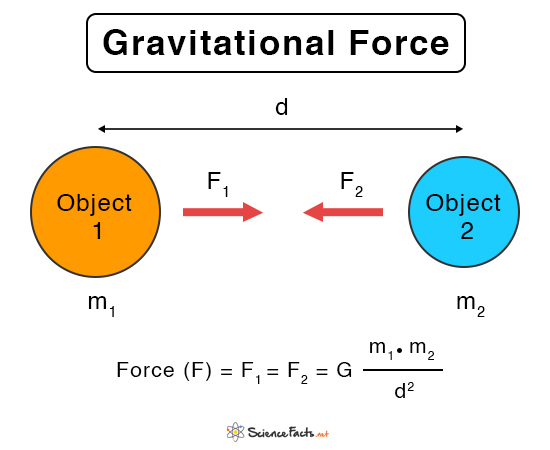
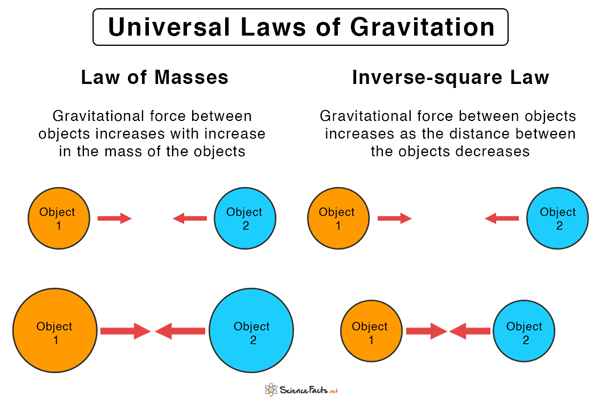
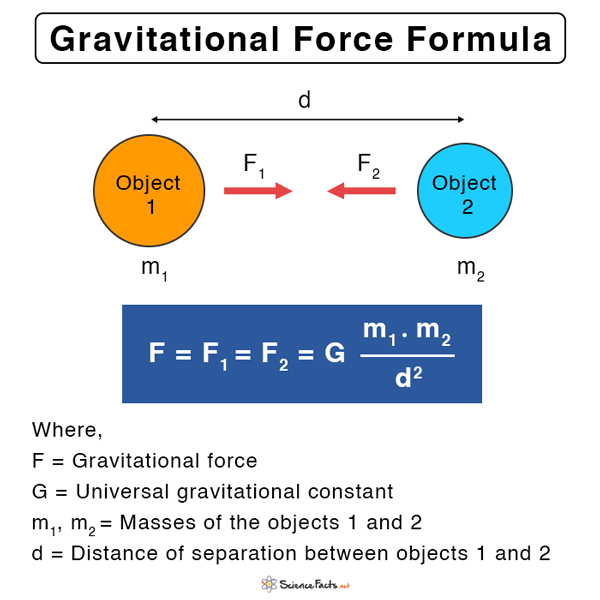
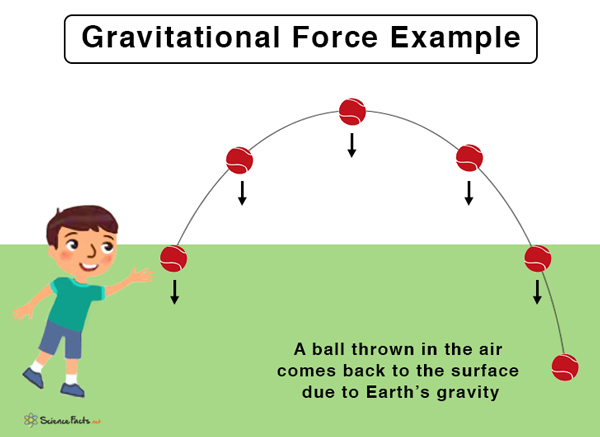
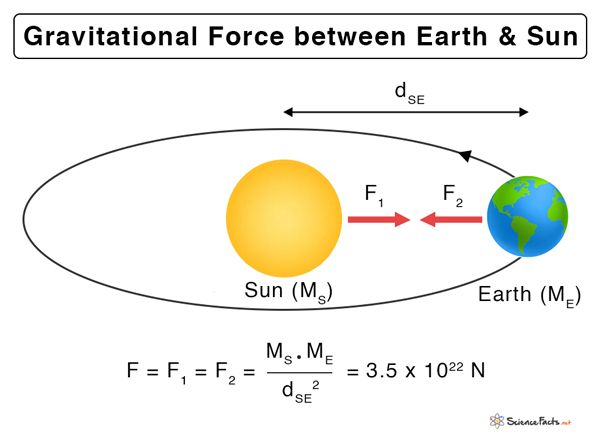







i have a problem with the decrease in gravity over distance
The gravitational force is inversely proportional to the distance between the massive bodies. Hence, decreases with distance.
hi.does F1 mean the direction of gravitational force exerted by object 1 on object 2 whereas F2 mean the direction of gravitational force exerted by object 2 on object 1?
F1 is the force exerted by object 2 on object 1. F2 is the force exerted by object 1 on object 2.
We will see a Representation of Hamilton.It’s Formular property does a Basic concept respect a book delongation.Any one had miss dynamic principle so it concludes the behaviourism of particle.
The equation will connect the coordinate of tangent and polar.A points of interesting are electron and degree to fixed point of weight.It influent to a simulation of atom which it approaches the chemical property relatively the Fluid property will remain a quality definition
I need more information about gravitational force
What kind of information you are looking for?
I see no description of WHAT gravity is. I am not asking about how it is measured. What causes one object to move toward another object.
Gravity has been defined in this article
The article explains how gravity works but no one seems to know what causes the gravitational force. We know that the magnetic force comes from the alignment of electrons and the result is either attraction or repulsion. But what is the explanation for why we have a gravitational force?
Due to warping of space-time by the mass of an object. It is beyond the scope of the article.